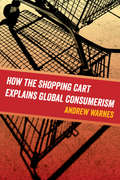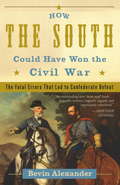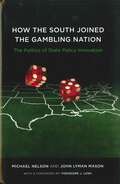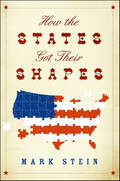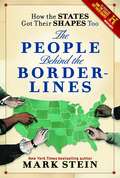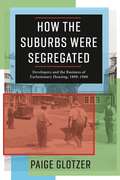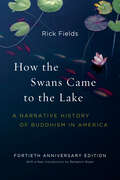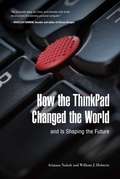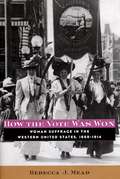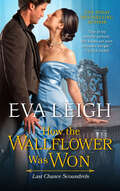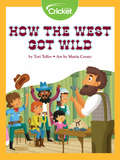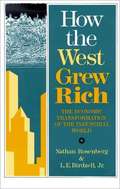- Table View
- List View
How the Shopping Cart Explains Global Consumerism
by Andrew WarnesPicture a familiar scene: long lines of shoppers waiting to check out at the grocery store, carts filled to the brim with the week’s food. While many might wonder what is in each cart, Andrew Warnes implores us to consider the symbolism of the cart itself. In his inventive new book, Warnes examines how the everyday shopping cart is connected to a complex web of food production and consumption that has spread from the United States throughout the world. Today, shopping carts represent choice and autonomy for consumers, a recognizable American way of life that has become a global phenomenon. This succinct and and accessible book provides an excellent overview of consumerism and the globalization of American culture.
How the South Could Have Won the Civil War: The Fatal Errors That Led to Confederate Defeat
by Bevin AlexanderAlexander posits the idea that the South could have won the Civil War given some tactical and strategic changes and better communication among the generals, rather than differing views about how to fight the war. He discusses how Jefferson Davis, Robert E. Lee, and Thomas "Stonewall" Jackson disagreed on strategy, the turning point battle that was never necessary, how the Confederate army never implemented its strategy to negate the Union's advantages in manpower and weaponry, how Abraham Lincoln saw the Union's problems better than the Confederacy's leaders, and how the South failed to learn from the lessons of its 1863 victory at Chancellorsville. Among the battles examined are those at Fredericksburg, Antietam, Gettsyburg, and Appomattox. Alexander is the author several books on military history, including Lost Victories. Annotation ©2008 Book News, Inc. , Portland, OR (booknews. com)
How the South Joined the Gambling Nation: The Politics of State Policy Innovation
by Michael Nelson Theodore J. Lowi John Lyman MasonA national map of legalized gambling from 1963 would show one state, Nevada, with casino gambling and no states with lotteries. Today's map shows eleven commercial casino states, most of them along the Mississippi River, forty-two states with state-owned lotteries, and racetrack betting, slot-machine parlors, charitable bingo, and Native American gambling halls flourishing throughout the nation. For the past twenty years, the South has wrestled with gambling issues. In How the South Joined the Gambling Nation, Michael Nelson and John Lyman Mason examine how modern southern state governments have decided whether to adopt or prohibit casinos and lotteries. Nelson and Mason point out that although the South participated fully in past gambling eras, it is the last region to join the modern movement embracing legalized gambling. Despite the prevalence of wistful, romantic images of gambling on southern riverboats, the politically and religiously conservative ideology of the modern South makes it difficult for states to toss their chips into the pot.The authors tell the story of the arrival or rejection of legalized gambling in seven southern states -- Mississippi, Louisiana, Tennessee, South Carolina, Georgia, Arkansas, and Alabama. The authors suggest that some states chose to legalize gambling based on the examples of other nearby states, as when Mississippi casinos spurred casino legalization in Louisiana and the Georgia lottery inspired lottery campaigns in neighboring South Carolina, Alabama, and Tennessee. Also important was the influence of Democratic policy entrepreneurs, such as Zell Miller in Georgia, Don Siegelman in Alabama, and Edwin Edwards in Louisiana, who wanted to sell the idea of gambling in order to sell themselves to voters. At the same time, each state had its own idiosyncrasies, such as certain provisions of their state constitutions weighing heavily as a factor.Nelson and Mason show that the story of gambling's spread in the South exemplifies the process of state policy innovation. In exploring how southern states have weighed the moral and economic risk of legalizing gambling, especially the political controversies that surround these discussions, Nelson and Mason employ a suspenseful, fast-paced narrative that echoes the oftentimes hurried decisions made by state legislators. Although each of these seven states fought a unique battle over gambling, taken together, these case studies help tell the larger story of how the South -- sometimes reluctantly, sometimes enthusiastically -- decided to join the gambling nation.
How the South Won the Civil War: Oligarchy, Democracy, and the Continuing Fight for the Soul of America
by Heather Cox RichardsonThis book is named one of The Washington Post's 50 Notable Works of Nonfiction. Heather Cox Richardson argues in this provocative work that democracy's blood-soaked victory was ephemeral. The system that had sustained the defeated South moved westward and there established a foothold. It was a natural fit. Settlers from the East had for decades been pushing into the West, where the seizure of Mexican lands at the end of the Mexican-American War and treatment of Native Americans cemented racial hierarchies. The South and West equally depended on extractive industries-cotton in the former and mining, cattle, and oil in the latter-giving rise a new birth of white male oligarchy, despite the guarantees provided by the 13th, 14th, and 15th Amendments, and the economic opportunities afforded by expansion. To reveal why this happened, How the South Won the Civil War traces the story of the American paradox, the competing claims of equality and subordination woven into the nation's fabric and identity.
How the Soviet Jew Was Made
by Sasha SenderovichA close reading of postrevolutionary Russian and Yiddish literature and film recasts the Soviet Jew as a novel cultural figure: not just a minority but an ambivalent character navigating between the Jewish past and Bolshevik modernity.The Russian Revolution of 1917 transformed the Jewish community of the former tsarist empire. In particular, the Bolshevik government eliminated the requirement that most Jews reside in the Pale of Settlement in what had been Russia’s western borderlands. Many Jews quickly exited the shtetls, seeking prospects elsewhere. Some left for bigger cities, others for Europe, America, or Palestine. Thousands tried their luck in the newly established Jewish Autonomous Region in the Far East, where urban merchants would become tillers of the soil. For these Jews, Soviet modernity meant freedom, the possibility of the new, and the pressure to discard old ways of life.This ambivalence was embodied in the Soviet Jew—not just a descriptive demographic term but a novel cultural figure. In insightful readings of Yiddish and Russian literature, films, and reportage, Sasha Senderovich finds characters traversing space and history and carrying with them the dislodged practices and archetypes of a lost Jewish world. There is the Siberian settler of Viktor Fink’s Jews in the Taiga, the folkloric trickster of Isaac Babel, and the fragmented, bickering family of Moyshe Kulbak’s The Zemlenyaners, whose insular lives are disrupted by the march of technological, political, and social change. There is the collector of ethnographic tidbits, the pogrom survivor, the émigré who repatriates to the USSR.Senderovich urges us to see the Soviet Jew anew, as not only a minority but also a particular kind of liminal being. How the Soviet Jew Was Made emerges as a profound meditation on culture and identity in a shifting landscape.
How the Sphinx Got to the Museum (How The ... Got To The Museum)
by Jessie HartlandDepicts how the Sphinx was commissioned by the Pharaoh, was built, was rediscovered after centuries and then travelled to New York.
How the States Got Their Shapes
by Mark SteinNew York Times Bestseller"Give me the splendid irregularities any day. God bless the panhandles and notches, the West Virginias and Oklahomas." -- Wall Street JournalWhy does Oklahoma have that panhandle? Did someone make a mistake? We are so familiar with the map of the United States that our state borders seem as much a part of nature as mountains and rivers. Even the oddities—the entire state of Maryland(!)—have become so ingrained that our map might as well be a giant jigsaw puzzle designed by Divine Providence. How the States Got Their Shapes is the first book to tackle why our state lines are where they are. Here are the stories behind the stories, right down to the tiny northward jog at the eastern end of Tennessee and the teeny-tiny (and little known) parts of Delaware that are not attached to Delaware but to New Jersey. Packed with fun oddities and trivia, this entertaining guide also reveals the major fault lines of American history, from ideological intrigues and religious intolerance to major territorial acquisitions. Adding the fresh lens of local geographic disputes, military skirmishes, and land grabs, Mark Stein shows how the seemingly haphazard puzzle pieces of our nation fit together perfectly.
How the States Got Their Shapes Too: The People Behind the Borderlines
by Mark SteinWas Roger Williams too pure for the Puritans, and what does that have to do with Rhode Island? Why did Augustine Herman take ten years to complete the map that established Delaware? How did Rocky Mountain rogues help create the state of Colorado? All this and more is explained in Mark Stein's new book.How the States Got Their Shapes Too follows How the States Got Their Shapes looks at American history through the lens of its borders, but, while How The States Got Their Shapes told us why, this book tells us who. This personal element in the boundary stories reveals how we today are like those who came before us, and how we differ, and most significantly: how their collective stories reveal not only an historical arc but, as importantly, the often overlooked human dimension in that arc that leads to the nation we are today.The people featured in How the States Got Their Shapes Too lived from the colonial era right up to the present. They include African Americans, Native Americans, Hispanics, women, and of course, white men. Some are famous, such as Thomas Jefferson, John Quincy Adams, and Daniel Webster. Some are not, such as Bernard Berry, Clarina Nichols, and Robert Steele. And some are names many of us know but don't really know exactly what they did, such as Ethan Allen (who never made furniture, though he burned a good deal of it).In addition, How the States Got Their Shapes Too tells of individuals involved in the Almost States of America, places we sought to include but ultimately did not: Canada, the rest of Mexico (we did get half), Cuba, and, still an issue, Puerto Rico. Each chapter is largely driven by voices from the time, in the form of excerpts from congressional debates, newspapers, magazines, personal letters, and diaries. Told in Mark Stein's humorous voice, How the States Got Their Shapes Too is a historical journey unlike any other you've taken. The strangers you meet here had more on their minds than simple state lines, and this book makes for a great new way of seeing and understanding the United States.From the Hardcover edition.
How the Streets Were Made: Housing Segregation and Black Life in America
by Yelena BaileyIn this book, Yelena Bailey examines the creation of "the streets" not just as a physical, racialized space produced by segregationist policies but also as a sociocultural entity that has influenced our understanding of blackness in America for decades. Drawing from fields such as media studies, literary studies, history, sociology, film studies, and music studies, this book engages in an interdisciplinary analysis of the how the streets have shaped contemporary perceptions of black identity, community, violence, spending habits, and belonging. Where historical and sociological research has examined these realities regarding economic and social disparities, this book analyzes the streets through the lens of marketing campaigns, literature, hip-hop, film, and television in order to better understand the cultural meanings associated with the streets. Because these media represent a terrain of cultural contestation, they illustrate the way the meaning of the streets has been shaped by both the white and black imaginaries as well as how they have served as a site of self-assertion and determination for black communities.
How the Suburbs Were Segregated: Developers and the Business of Exclusionary Housing, 1890–1960 (Columbia Studies in the History of U.S. Capitalism)
by Paige GlotzerThe story of the rise of the segregated suburb often begins during the New Deal and the Second World War, when sweeping federal policies hollowed out cities, pushed rapid suburbanization, and created a white homeowner class intent on defending racial barriers. Paige Glotzer offers a new understanding of the deeper roots of suburban segregation. The mid-twentieth-century policies that favored exclusionary housing were not simply the inevitable result of popular and elite prejudice, she reveals, but the culmination of a long-term effort by developers to use racism to structure suburban real estate markets.Glotzer charts how the real estate industry shaped residential segregation, from the emergence of large-scale suburban development in the 1890s to the postwar housing boom. Focusing on the Roland Park Company as it developed Baltimore’s wealthiest, whitest neighborhoods, she follows the money that financed early segregated suburbs, including the role of transnational capital, mostly British, in the U.S. housing market. She also scrutinizes the business practices of real estate developers, from vetting homebuyers to negotiating with municipal governments for services. She examines how they sold the idea of the suburbs to consumers and analyzes their influence in shaping local and federal housing policies. Glotzer then details how Baltimore’s experience informed the creation of a national real estate industry with professional organizations that lobbied for planned segregated suburbs. How the Suburbs Were Segregated sheds new light on the power of real estate developers in shaping the origins and mechanisms of a housing market in which racial exclusion and profit are still inextricably intertwined.
How the Swans Came to the Lake: A Narrative History of Buddhism in America
by Rick Fields Benjamin BoginThis new updated edition of How the Swans Came to the Lake includes much new information about recent events in Buddhist groups in America and discusses such issues as spiritual authority, the role of women, and social action.
How the Swans Came to the Lake: A Narrative History of Buddhism in America
by Rick FieldsThis new updated edition of How the Swans Came to the Lake includes much new information about recent events in Buddhist groups in America and discusses such issues as spiritual authority, the role of women, and social action.
How the ThinkPad Changed the World—and Is Shaping the Future
by William Holstein Arimasa NaitohThe ThinkPad notebook computer has been at the center of the digital revolution that has transformed millions of lives around the world, allowing users to obtain access to their documents, pictures and other personal data from virtually anywhere at any time. More than 100 million ThinkPads have been sold since they were introduced in 1992, some twenty-five years ago. ThinkPads played a prominent role in NASA's space exploration and at the International Space Station. They accompanied explorers who traversed the entire length of the Nile River and conquered Mount Everest. ThinkPads also played a major role in changing the very architecture of how humanity's knowledge is stored and made available.In this book, Arimasa Naitoh, the father of the ThinkPad, collaborates with American business journalist and author William J. Holstein to write candidly about the incredible technological and personal struggles he and fellow engineers faced. And he offers his vision of the future of mobile computing—because this revolution is not even close to being finished.
How the U.S. Government Works: ...and how it all comes together to make a nation
by Syl Sobel J.D.This updated, easy-to-read book about the United States for kids explains the federal system as it works today. It also discusses why the framers of the Constitution created the U.S. government in the 18th century and the purposes it was designed to serve.Parents, teachers, and gift givers will find:an easy-to-read book about a complex subject revised for the classroom and homecurriculum aligned vocabulary, expanded glossary, discussion questions, and resource guideinformation on how presidents and other officials are elected or appointedDescribed are the Legislative branch, composed of the Senate and the House of Representatives; the Executive branch, headed by the President with the Cabinet members; and the Judicial branch, comprised of the Supreme Court of the United States and the lower federal courts throughout the nation.
How the U.S. Government Works: A Kid's Guide to Civics
by Syl Sobel J.D.Newly updated edition!Discover everything you need to know about American democracy with this easy-to-read guide to our government!How the U.S. Government Works is a fact-packed primer that helps kids understand the many facets of America's federal system. Readers will learn about how the government came to be, the responsibilities of the Executive, Legislative, and Judicial branches, and how our democracy impacts their own lives today!
How the Vertebrate Brain Regulates Behavior: Direct from the Lab
by Donald PfaffThroughout his career, Donald Pfaff has demonstrated that by choosing problems and methods with care, biologists can study the molecular mechanisms of brains more complex than those of fruit flies, snails, and roundworms. He offers a close-up, conversational perspective on a 50-year quest to understand how behavior is regulated in vertebrates.
How the Victorians Took Us to the Moon: The Story of the 19th-Century Innovators Who Forged Our Future
by Iwan Rhys MorusThe rich and fascinating history of the scientific revolution of the Victorian Era, leading to transformative advances in the twentieth and twenty-first centuries.The Victorians invented the idea of the future. They saw it as an undiscovered country, one ripe for exploration and colonization. And to get us there, they created a new way of ordering and transforming nature, built on grand designs and the mass-mobilization of the resources of the British Empire. With their expert culture of accuracy and precision, they created telegraphs and telephones, electric trams and railways, built machines that could think, and devised engines that could reach for the skies. When Cyrus Field&’s audacious plan to lay a telegraph cable across the Atlantic finally succeeded in 1866, it showed how science, properly disciplined, could make new worlds. As crowds flocked to the Great Exhibition of 1851 and the exhibitions its success inaugurated, they came to see the future made fact—to see the future being built before their eyes. In this rich and absorbing book, a distinguished historian of science tells the story of how this future was made. From Charles Babbage&’s dream of mechanizing mathematics to Isambard Kingdom Brunel&’s tunnel beneath the Thames to George&’s Cayley&’s fantasies of powered flight and Nikola Tesla&’s visions of an electrical world, it is a story of towering personalities, clashing ambitions, furious rivalries and conflicting cultures—a rich tapestry of remarkable lives that transformed the world beyond recognition and ultimately took mankind to the Moon
How the Vote Was Won: Woman Suffrage in the Western United States, 1868-1914
by Rebecca MeadUncovers how women in the West fought for the right to voteBy the end of 1914, almost every Western state and territory had enfranchised its female citizens in the greatest innovation in participatory democracy since Reconstruction. These Western successes stand in profound contrast to the East, where few women voted until after the ratification of the Nineteenth Amendment in 1920, and the South, where African-American men were systematically disenfranchised. How did the frontier West leap ahead of the rest of the nation in the enfranchisement of the majority of its citizens?In this provocative new study, Rebecca J. Mead shows that Western suffrage came about as the result of the unsettled state of regional politics, the complex nature of Western race relations, broad alliances between suffragists and farmer-labor-progressive reformers, and sophisticated activism by Western women. She highlights suffrage racism and elitism as major problems for the movement, and places special emphasis on the political adaptability of Western suffragists whose improvisational tactics earned them progress.A fascinating story, previously ignored, How the Vote Was Won reintegrates this important region into national suffrage history and helps explain the ultimate success of this radical reform.
How the Wallflower Was Won (Last Chance Scoundrels #2)
by Eva LeighUSA TODAY bestselling author Eva Leigh continues her Last Chance Scoundrels series with a steamy romance between two opposites—a rogue with a taste for wagers and a bookish wallflower—who marry for convenience... but neither bet on falling in love.Finn Ransome is an expert on Lady Luck, which is why he refuses to take a chance on love. Experience has taught him that he’s happier at a gaming table than around people he will, inevitably, disappoint. However, the clock is ticking on his father’s matrimonial demands. But the only woman to catch his eye is a bluestocking who would never consider a rogue like him.After a disastrous first Season, Tabitha Seaton decided to focus on books instead of ballrooms. She hopes to join the Sterling Society, a collective of the most brilliant, influential minds in London. Except, they will never admit an unmarried lady. Now Tabitha needs a husband, and a notorious, handsome gambler may be her best bet.Finn and Tabitha are opposites who have no intention of wagering on a love match, and a calculated marriage of convenience solves all their problems—with no risk to their hearts. Once married, however, their potent attraction boils over into a deep passion that neither expected. When a painful mistake drives the new lovers apart, Finn will risk it all to prove a scoundrel and a wallflower are a winning pair...
How the Wallflower Wins a Duke
by Lucy MorrisBe tantalized by this spicy Regency romanceMarina Fletcher&’s Rules: Rule 1: Spend life composing music in peace. Do not worry about finding a husband. Rule 2: If must worry about finding a husband, marry for love only or commit to becoming a spinster. Rule 3: Resist urge to spend time with the sinfully sexy Duke of Framlingham, who clearly does not believe in love. Rule 4: Never ever say yes to said duke&’s wicked plan for us to silence society&’s expectations with a fake engagement…But what happens when this wallflower breaks every single rule?From Harlequin Historical: Your romantic escape to the past.
How the War Was Won: Command and Technology in the British Army on the Western Front: 1917-1918 (Pen And Sword Military Classics Ser.)
by T.H.E. Travers"How the War Was Won" describes the major role played by the British Expeditionary Force on the Western Front in defeating the German army. In particular, the book explains the methods used in fighting the last year of the war, and raises questions as to whether mechanical warfare could have been more widely used. Using a wide range of unpublished
How the War was Won
by Phillips Payson O'BrienWorld War II is usually seen as a titanic land battle, decided by mass armies, most importantly those on the Eastern Front. Phillips Payson O'Brien shows us the war in a completely different light. In this compelling new history of the Allied path to victory, he argues that in terms of production, technology and economic power, the war was far more a contest of air and sea than land supremacy. He shows how the Allies developed a predominance of air and sea power which put unbearable pressure on Germany and Japan's entire war-fighting machine from Europe and the Mediterranean to the Pacific. Air and sea power dramatically expanded the area of battle and allowed the Allies to destroy over half the Axis' equipment before it had even reached the traditional 'battlefield'. Battles such as El Alamein, Stalingrad and Kursk did not win World War II; air and sea power did.
How the West Became Antisemitic: Jews and the Formation of Europe, 800–1500
by Ivan G. MarcusAn examination of how the Jews—real and imagined—so challenged the Christian majority in medieval Europe that it became a society that was religiously and culturally antisemitic in new ways In medieval Europe, Jews were not passive victims of the Christian community, as is often assumed, but rather were startlingly assertive, forming a Jewish civilization within Latin Christian society. Both Jews and Christians considered themselves to be God&’s chosen people. These dueling claims fueled the rise of both cultures as they became rivals for supremacy. In How the West Became Antisemitic, Ivan Marcus shows how Christian and Jewish competition in medieval Europe laid the foundation for modern antisemitism.Marcus explains that Jews accepted Christians as misguided practitioners of their ancestral customs, but regarded Christianity as idolatry. Christians, on the other hand, looked at Jews themselves—not Judaism—as despised. They directed their hatred at a real and imagined Jew: theoretically subordinate, but sometimes assertive, an implacable &“enemy within.&” In their view, Jews were permanently and physically Jewish—impossible to convert to Christianity. Thus Christians came to hate Jews first for religious reasons, and eventually for racial ones. Even when Jews no longer lived among them, medieval Christians could not forget their former neighbors. Modern antisemitism, based on the imagined Jew as powerful and world dominating, is a transformation of this medieval hatred.A sweeping and well-documented history of the rivalry between Jewish and Christian civilizations during the making of Europe, How the West Became Antisemitic is an ambitious new interpretation of the medieval world and its impact on modernity.
How the West Got Wild
by Tori TelferChummy and Sandra Bee were the rowdiest little kids in Ruby, Arizona. But when they helped start the gold rush in Ruby, people stopped calling them "wild" and "rambunctious" and started calling them "plucky" and "clever."
How the West Grew Rich: The Economic Transformation of the Industrial World
by Nathan Rosenberg L. E. BirdzellHow did the West—Europe, Canada, and the United States—escape from immemorial poverty into sustained economic growth and material well-being when other societies remained trapped in an endless cycle of birth, hunger, hardship, and death? In this elegant synthesis of economic history, two scholars argue that it is the political pluralism and the flexibility of the West's institutions—not corporate organization and mass production technology—that explain its unparalleled wealth.
